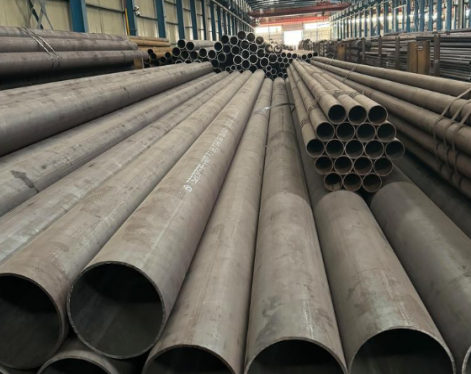Firstly, the importance of controlling the reinforcement of the inner and outer welds of submerged arc welded seamless steel pipes for transportation is discussed. If the balance of the weld is large, the stress convergence coefficient of the weld will be large, which will simply constitute a stress corrosion crack. The outer weld seam is huge, which is unlucky for anti-corrosion; the inner weld seam is huge, which will increase the power to transport the medium and lose it.
The uation of the welding quality of submerged arc welded seamless steel pipes firstly depends on whether the reinforcement of the inner and outer welds and their shapes are well controlled, and whether the weld flow lines are regular. If the weld margin is huge and does not transition smoothly, the stress concentration factor at the weld toe part of the weld will be large, which is unlucky for the hostile SCC. In addition, the large external weld seam will increase the stale operation of the pipe and increase the cost.
If the excess of internal welding is huge, the frictional resistance to the pipeline transportation medium will be large, and the pipeline transportation will consume more energy. Therefore, when producing submerged arc welded pipes, it is necessary to control the reinforcement of the inner and outer welds. The regular weld reinforcement in the API5L standard is only the minimum standard, while the oil and gas transportation pipelines and marine pipes all control the weld reinforcement below 2.5mm.
The stress convergence of the butt joint is mainly caused by the weld reinforcement. The more severe the reinforcement of the weld, the strength of the welded joint will decrease instead. After welding, the residual height is flattened, and it only needs to be no lower than the base metal to reduce stress convergence, and sometimes it can increase the strength of the welded joint. The smaller the corner radius of the weld, the greater the degree of stress convergence; conversely, the smaller the degree of stress convergence. Therefore, the requirements for the submerged arc welding seam: first, the reinforcement should be small; second, the welding seam should be smooth and excessive, so that the turning radius R value increases.
The welds of submerged arc welded seamless steel pipes are the welds of butt joints. If the weld reinforcement and corner radius are not well controlled, the stress at the weld toe will be large, causing the welded pipe to be in service especially in corrosive media. Medium, stress corrosion cracking easily occurs at the weld toe.
In order to prevent the occurrence of stress corrosion cracks at the weld toe, it is necessary to control the remaining stress during forming and welding, especially the remaining stress at the weld toe.
The uation of the welding quality of submerged arc welded seamless steel pipes firstly depends on whether the reinforcement of the inner and outer welds and their shapes are well controlled, and whether the weld flow lines are regular. If the weld margin is huge and does not transition smoothly, the stress concentration factor at the weld toe part of the weld will be large, which is unlucky for the hostile SCC. In addition, the large external weld seam will increase the stale operation of the pipe and increase the cost.
If the excess of internal welding is huge, the frictional resistance to the pipeline transportation medium will be large, and the pipeline transportation will consume more energy. Therefore, when producing submerged arc welded pipes, it is necessary to control the reinforcement of the inner and outer welds. The regular weld reinforcement in the API5L standard is only the minimum standard, while the oil and gas transportation pipelines and marine pipes all control the weld reinforcement below 2.5mm.
The stress convergence of the butt joint is mainly caused by the weld reinforcement. The more severe the reinforcement of the weld, the strength of the welded joint will decrease instead. After welding, the residual height is flattened, and it only needs to be no lower than the base metal to reduce stress convergence, and sometimes it can increase the strength of the welded joint. The smaller the corner radius of the weld, the greater the degree of stress convergence; conversely, the smaller the degree of stress convergence. Therefore, the requirements for the submerged arc welding seam: first, the reinforcement should be small; second, the welding seam should be smooth and excessive, so that the turning radius R value increases.
The welds of submerged arc welded seamless steel pipes are the welds of butt joints. If the weld reinforcement and corner radius are not well controlled, the stress at the weld toe will be large, causing the welded pipe to be in service especially in corrosive media. Medium, stress corrosion cracking easily occurs at the weld toe.
In order to prevent the occurrence of stress corrosion cracks at the weld toe, it is necessary to control the remaining stress during forming and welding, especially the remaining stress at the weld toe.









